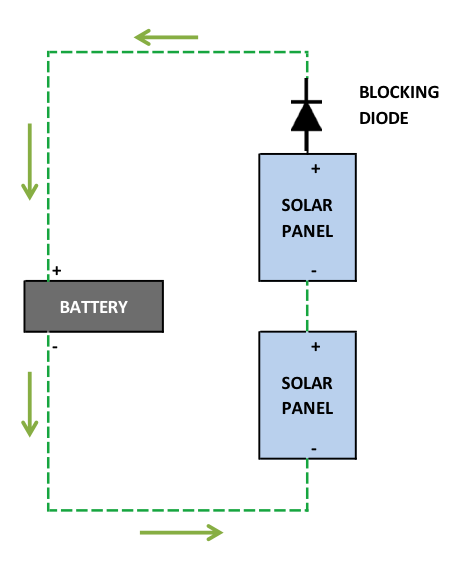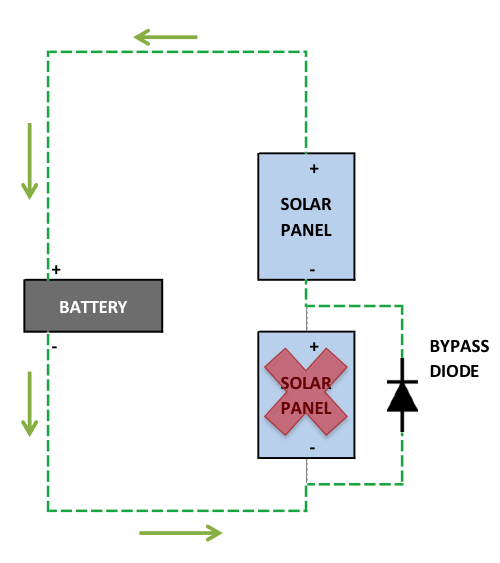Blocking Diode and Bypass Diode for Solar Panels
A blocking diode and bypass diode are commonly used in solar energy systems and solar panels. Learn how and why blocking diodes and bypass diodes are used.
Diode and unidirectional flow of current
In simplest terms a diode can be understood as a two terminal electronic device, which allows electrical current to pass in one direction. Diodes are made of a semiconductor material, usually silicon, although materials like selenium and germanium are sometimes used in its construction. A diode only allows unidirectional flow of current. This is due to the fact that it offers low (ideally zero) resistance to current in one direction and at the same time, offers high (ideally infinite) resistance to the current in the opposite direction. This property of a diode is extensively used in the photovoltaic industry. Figure 1 shows the most common symbol for a diode found in a lot of circuit diagrams, however there could be variants. Figure 1: Electrical diagram bypass diode used for solar panel
Figure 1: Electrical diagram bypass diode used for solar panel
How are blocking diodes and bypass diodes used in solar installations?
Diodes are extensively used in solar panel installations. Since the prevent backflow of current (unidirectional flow of current), they are used as blocking devices. They are also used as bypass devices to maintain the reliability of the entire solar power system in the event of a solar panel failure. Therefore, the two main types of diodes used in a solar system are:
Blocking Diode:
A blocking diode allows the flow of current from a solar panel to the battery but prevents/blocks the flow of current from battery to solar panel thereby preventing the battery from discharging.
Bypass Diode:
A bypass diode is used in case one of the panels of a multi panel string is faulty, it bypasses the faulty panel by providing current an alternative path to flow and thereby maintains the continuity of power production.
Blocking diode configuration
Figure 2 shows the simple working of a blocking diode. Electricity flows from high potential to low potential. Figure 2: Blocking diode in solar system
Figure 2: Blocking diode in solar system
In this setup, during the day the solar panel (at high potential) produces electricity and charges the battery (at low potential). During night, when the panel is not producing any electricity (low potential), the battery is at a higher potential. There is a possibility of the current flowing from the battery to the solar panel, thereby discharging the battery overnight. To prevent this from happening, a blocking diode is installed. It allows the current to flow from the panel to the battery but blocks the flow in opposite direction. It is always installed in series with the solar panel.
Bypass diode configuration
Figure 3 shows the simple working of a bypass diode. In this setup, one of the solar panel is faulty and is not producing any current. Figure 3: Bypass diode in solar system
Figure 3: Bypass diode in solar system
The bypass diode in this case provides an alternate path for the current to flow and completes the circuit. It also prevents the current from other panels which are working (at high potential) to flow back to the faulty panel (at low potential). Thus even when a panel is faulty, the bypass diode still makes the whole solar system run and produce electricity at a lower rate. The bypass diodes should be installed in parallel to the panel.
You’ve learned how blocking and bypass diodes impact off-grid solar systems, now make sure your design and modules meet quality requirements. Request your quote today with our experts.

Magombe rashidi
on 17 Mar 2024Tokoza
on 11 Apr 2023Ch
on 04 Jun 2017SteveNC
on 14 Aug 2017Connor Kalvig
on 22 Feb 2019Dzung Hoang
on 21 Apr 2022Harish
on 29 Nov 2018Mohitha
on 16 Feb 2019Li
on 16 Oct 2019